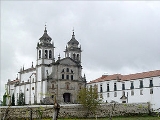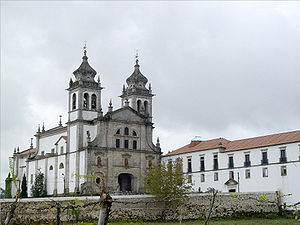
Monastery of Tibães
Encyclopedia

Monastery
Monastery denotes the building, or complex of buildings, that houses a room reserved for prayer as well as the domestic quarters and workplace of monastics, whether monks or nuns, and whether living in community or alone .Monasteries may vary greatly in size – a small dwelling accommodating only...
situated in the parish of Mire de Tibães, near Braga
Braga
Braga , a city in the Braga Municipality in northwestern Portugal, is the capital of the Braga District, the oldest archdiocese and the third major city of the country. Braga is the oldest Portuguese city and one of the oldest Christian cities in the World...
, in northern Portugal
Portugal
Portugal , officially the Portuguese Republic is a country situated in southwestern Europe on the Iberian Peninsula. Portugal is the westernmost country of Europe, and is bordered by the Atlantic Ocean to the West and South and by Spain to the North and East. The Atlantic archipelagos of the...
. It was the mother house of the Benedictine order in Portugal and Brazil
Brazil
Brazil , officially the Federative Republic of Brazil , is the largest country in South America. It is the world's fifth largest country, both by geographical area and by population with over 192 million people...
, and it is known for the exuberant Rococo
Rococo
Rococo , also referred to as "Late Baroque", is an 18th-century style which developed as Baroque artists gave up their symmetry and became increasingly ornate, florid, and playful...
decoration of its church.
History
The first information about a monastic community in the region - the Monastery of DumioDumio
The Monastery of Dumio , is a former paleo-Christian monastery in the civil parish of Dume, municipality of Braga, in northwestern portio of Portugal. Originally a Roman villa, it was the base of a basilica by Suebi tribes, and later Christian monastery headed by Martin of Braga in the 6th century...
, close to Tibães, founded by Saint Martin of Braga - dates from the 6th century.
The Monastery of Tibães was founded around 1060, and its feudal rights were granted by Henry of Burgundy
Henry, Count of Portugal
Henry of Burgundy, Count of Portugal was Count of Portugal from 1093 to his death. He was brother of Hugh I, Duke of Burgundy, and Odo I, Duke of Burgundy, all sons of Henry, the heir of Robert I, Duke of Burgundy. His name is Henri in modern French, Henricus in Latin, Enrique in modern Spanish...
, Count of Portugal, in 1110. During the Middle Ages, after the Kingdom of Portugal became independent, rich and vast proterties in the North of the country came into the possession of the Monastery. However, due to the extensive reconstruction work carried out in the 17th and 18th centuries, there are no architectural remnants from this early stage of the ensemble.
In 1567, the Monastery of Tibães became the mother house of the Order of Saint Benedict
Order of Saint Benedict
The Order of Saint Benedict is a Roman Catholic religious order of independent monastic communities that observe the Rule of St. Benedict. Within the order, each individual community maintains its own autonomy, while the organization as a whole exists to represent their mutual interests...
for Portugal
Portugal
Portugal , officially the Portuguese Republic is a country situated in southwestern Europe on the Iberian Peninsula. Portugal is the westernmost country of Europe, and is bordered by the Atlantic Ocean to the West and South and by Spain to the North and East. The Atlantic archipelagos of the...
and the colony of Brazil
Brazil
Brazil , officially the Federative Republic of Brazil , is the largest country in South America. It is the world's fifth largest country, both by geographical area and by population with over 192 million people...
, with the first general gathering of the Order happening in Tibães in 1570. In the first half of the 17th century, in view of the ruined condition of the old monastery and the vast resources at their disposal, the monks began the radical rebuilding that gave origin to the ensemble that exists today. The works began with the cloisters (Refectory and Cemetery cloisters) and the church, which was built between 1628 and 1661 in Mannerist style by architects Manuel Álvares and João Turriano. By the beginning of the 18th century the new wings of the Monastery were finished, including the Gate House, the Dormitory, the Guest House, the Chapter House
Chapter house
A chapter house or chapterhouse is a building or room attached to a cathedral or collegiate church in which meetings are held. They can also be found in medieval monasteries....
and the Library.
During the 17th and 18th centuries, the Monastery was a site of considerable artistic activity and had an enormous influence in the Baroque
Baroque
The Baroque is a period and the style that used exaggerated motion and clear, easily interpreted detail to produce drama, tension, exuberance, and grandeur in sculpture, painting, literature, dance, and music...
and Rococo
Rococo
Rococo , also referred to as "Late Baroque", is an 18th-century style which developed as Baroque artists gave up their symmetry and became increasingly ornate, florid, and playful...
art of Northern Portugal and overseas colonies. In the years 1757-1760, architect André Soares
André Soares
André Soares Ribeiro da Silva, more commonly known as André Soares was a leading Portuguese sculptor and architect active in Northern Portugal during the 18th century....
designed the main altarpiece
Altarpiece
An altarpiece is a picture or relief representing a religious subject and suspended in a frame behind the altar of a church. The altarpiece is often made up of two or more separate panels created using a technique known as panel painting. It is then called a diptych, triptych or polyptych for two,...
and the woodwork of the triumphal arch of the main chapel, as well as the pulpit
Pulpit
Pulpit is a speakers' stand in a church. In many Christian churches, there are two speakers' stands at the front of the church. Typically, the one on the left is called the pulpit...
s and lateral altarpieces, all of which are landmarks in Portuguese Rococo art. The gilded woodwork was sculpted by famed José de Santo António Vilaça. Many statues in the church are by the hand of another celebrated sculptor, Cipriano da Cruz.
Sold at an auction sale in 1864, the Tibães Monastery and all its surrounding areas fell into decay and ruin. A great part of the ensemble, including the Refectory Cloister, was destroyed in a fire in 1894. In 1986 the Monastery became a State property and an extensive recovery project was started that continues to this day.

